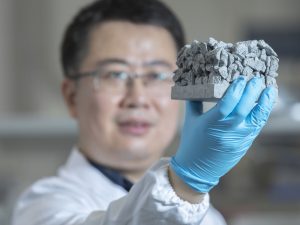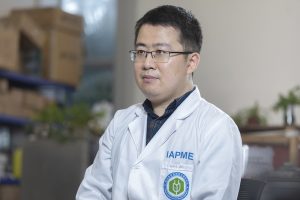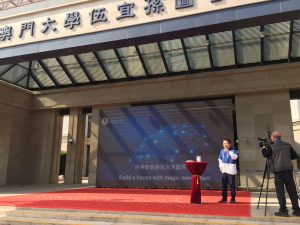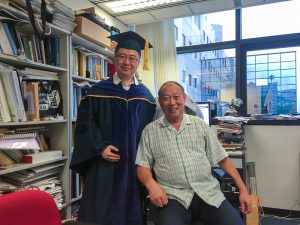Sun Guoxing, an Assistant Professor in the Faculty of Science and Technology (FST) and Institute of Applied Physics and Materials Engineering (IAPME) at the University of Macau (UM), is the first person to propose using cement to make nanoparticles. Interestingly, as a brilliant researcher who has developed a world-record-breaking material, Sun was quite unimpressive in his college years. In fact, he was anything but the typical straight-A student who breezes through college, reaping awards and accolades along the way. Rather, he was consistently at the bottom of his class. After three years of doctoral studies in chemical engineering, he was advised by his supervisor to withdraw from the programme. Desperate to find a new path, he switched to construction materials, a sub‑field of civil engineering, and finally began to blossom. Over the years, he has experienced ups and downs in his academic career. But he has never forgotten why he wanted to become a researcher in the first place—to give back to society by doing work that makes a difference. So he plodded on, applying his multidisciplinary background to his research in advanced materials. Breakthroughs came. Records were broken. Eventually he began to shine.
Scientific Research with a Social Impact
Sun’s laboratory is located on the ground floor of the IAPME building; it is a joint laboratory operated with Prof Li Zongjin of the same institute. About 240 square meters in size, this laboratory is arranged like a production department. When Sun joined UM in 2017, it was just a roughcast space, which he designed and built into the current laboratory with Prof Li.
Prof Sun was the first to discover that by putting cement into ice water, he can obtain small five‑nm particles that can be used to make high‑performance nanomaterials. At UM, Prof Sun and his team invented a series of new hydrogels made of nanoparticles derived from cement. What initially caught their eyes was the excellent mechanical properties of the gel. For example, it can be compressed to 1 per cent of its original size and return to its original size within one second. The team took advantage of this special property and developed three products. The first product can absorb four times its weight of organic pigments. The second product has extremely high electrical conductivity and excellent plasticity, and can be used as a flexible sensor material with high conductivity. The third product is a super‑absorbent resin, which can absorb up to 13,600 times its own super‑absorbent resin weight of water; this is two to three times the previous world record. ‘The water content of this gel that has absorbed water reaches 99.993 per cent; you can’t find another substance with higher water content,’ says Prof Sun.
Ups and Downs in His Student Years
Born in Huai’an city, Jiangsu province, Sun almost monopolised the top spot in the city’s standardised examinations for high school students. When preparing for college, he selected Tsinghua University’s automation engineering programme as his first choice, which was the programme with the highest admission standard at Tsinghua University. Unfortunately, he fell short of the necessary admission marks by five points. He ended up studying chemistry at BeijingNormal University, which was not among his original choices for a college major. A 17‑year‑old young man who had just been denied admission to his favourite university to study a major of his choice, Sun felt completely disoriented and demoralised. As a result, he idled away his first three years in college, and sat firmly at the bottom of his class. ‘I was constantly doubting myself and everything I did, and I lost hope for my future,’ he says. ‘Fortunately, I met Prof Liu Zhengping, the first mentor in my life. He asked me to join one of his research groups, and gave me my first exposure to scientific research. By the time I graduated, my thesis was almost nominated for an excellent undergraduate thesis.’
When Sun graduated in 2004, Prof Liu encouraged him to pursue a master’s degree at the university.Sun took his advice, but failed the necessary tests inEnglish and politics. So he returned to his hometown, teaching chemistry in a local vocational school while fervently studying English in his spare time. He took and failed the master’s entrance examination three times before he was finally admitted. Looking back, he says: ‘I was only 21 years old, but I knew I had to go all out and give it a try, because if I made it, at least I would have a chance to change my life.’Soon after starting his master’s studies, and based on his outstanding research performance, Sun was recommended by his supervisor Prof Liu for a joint training programme conducted by the university and the Institute of Chemistry of the Chinese Academy of Sciences (ICCAS). ‘My research and training were both completed at ICCAS. Prof Chen Guangming of ICCAS played a very important guiding role in my research,’ says Prof Sun. He did not let down his mentors who had great expectations for him. In just two years, he published three papers in journals indexed in Science Citation Index and one paper in a core journal.
Sun’s education journey was anything but smooth sailing. In 2009, when he graduated from his master’s programme, he missed the deadline for applying for a government‑sponsored PhD programme overseas, so he found a job in an education group as a chemistry teacher and became a ‘star teacher’ in only six months. This experience honed his teaching skills, but his eyes were set on bigger goals. During the one year when he worked as a teacher, Sun wrote more than 200 application letters for PhD programmes. Eventually, he received offers from four universities, including Delft University of Technology, one of the four major technology universities in Europe, and the HongKong University of Science and Technology (HKUST).He finally chose HKUST.
Finding Space for Innovation in anInterdisciplinary Field
Sun’s first doctoral supervisor was Prof Chan ChiMing in the Department of Chemical and BiologicalEngineering at HKUST. ‘The focus of my doctoral research at that time was the study of traditional polymer crystallisation theory. ‘My supervisor didn’t think I was right for this direction, much less likely to achieve any breakthroughs, so he advised me to withdraw from the programme, saying that otherwise I may not be able to graduate,’ recalls Sun.
Feeling utterly demoralised, Sun quit the programme.A few days later, he sent an email to Prof Li Zongjin in the Department of Civil and EnvironmentalEngineering, in which he explained his situation and sought Prof Li’s advice and help. Prof Li did not want to see Sun’s three years of studies end in vain, so he asked Sun to join his research group so he could finish his PhD degree. ‘Civil engineering opened up a new world for me. It was like “discovering a new continent”,’ says Sun. ‘Prof Li’s guidance shaped my philosophy of scientific research and management.’
Thanks to his solid knowledge of chemical technology, in June 2013, less than a month after he joinedProf Li’s group, Sun discovered some chemical technologies that can be applied to the field of building materials. Three months later, he published his first research article on materials in a SCI‑indexed journal. To this day, he still remembers the excitement he felt when he first discovered five‑nanometre particles in cement suspension under an electronic microscope. Following that discovery, he became the first in the world to propose the use of cement to make the world’s cheapest, mass‑producible nanoparticles. ‘That was when I began to realise that product innovation and theoretical innovation were what I was best at,’ he says.
Sun completed his PhD programme in civil engineering within a year and a half. After graduation, he first worked as a research and development engineer at Nano and Advanced Materials Institute Limited (NAMI)in Hong Kong while simultaneously holding a part‑time position as a postdoctoral researcher at HKUST. Within two years, he created two inventions, an innovative nano‑foam that can remain stable in the air for up to two years and a lightweight and high‑strength foamed cement made from the nano‑foam.
A Strong Motivation for Research
In 2017, Sun visited UM for the first time and fell in love with its academic ambience. Later, he decided to joinUM. He has worked with his mentor Prof Li Zongjin on research projects and postgraduate training. So far, they have jointly supervised more than 20 doctoral and postdoctoral students. ‘Research has always been my greatest passion, and being able to give back to society with research makes it even better,’ says Prof Sun.
Transforming research results into products that are useful to society has always been the driving force behind Prof Sun’s research. Earlier, Zhuhai UMScience & Technology Research Institute established a demonstration base for industry‑academia collaboration in Hengqin, Zhuhai, in Guangdong province. Prof Sun quickly saw the opportunity. He plans to set up a small production line in the research institute so he can use the products developed as intermediate raw materials such as a water‑absorbing swelling agent, which he hopes can be applied in the future to farmland water retention and desert management. ‘We plan to first produce the swelling agent in the form of powder and then find some companies that make water‑absorbent resins to produce products for everyday use, such as diapers or farmland water‑retaining agents,’ he says.‘We plan to launch the products onto the market withZhuhai Gaolan Port Industrial Park, which is the biggest industrial park in western Guangdong.’
Prof Sun has found the space for innovation in an interdisciplinary field. As he often says to his students:‘As long as you don’t give up, you will succeed eventually.’ He looks at the road ahead with confidence and excitement, saying: ‘There is still a vast uncharted territory for me to explore.’
Prof Sun Guoxing’s main research interests include polymer cement‑based nanocomposites, polymer crystallisation, concrete admixtures, preparing nanoparticle‑reinforced polymer hydrogels via cement hydration, and nanoparticle‑stabilised foams. He was the first to propose the use of cement to make the cheapest, mass‑producible nanoparticles. He has published more than 50 academic papers and has applied for six Chinese invention patents (one already granted) as the first or main inventor, and he holds one US invention patent. In 2019, he received the Scientist Medal from the International Advanced Materials Association.
Source: UMagazine Issue 22
澳門大學科技學院及應用物理及材料工程研究院助理教授孫國星是首位提出用水泥製造最便宜納米顆粒的專家。回憶求學之路,原來他大學時成績幾乎倒數第一,博士讀化學工程三年後又被導師勸退,轉讀土木工程建築材料後彷如發現新大陸。這些年來,他堅持以研究為使命的初心,由於擁有跨學科背景,在研究上屢獲突破性發展。
科研著重成果轉化
孫國星教授的實驗室位於應用物理及材料工程研究院地面層,這裏也是他與同院的李宗津教授的聯合實驗室,約240平方米的空間,佈置得像車間一樣。他在2017年加入澳大時,當時實驗室還是毛坯房,是與李教授一手一腳設計建立起來。
孫國星率先發現,把水泥放進冰水, 就可以在液體中得到只有五納米大小的顆粒,用於製造各種性能優異的納米材料。在澳大,孫教授和團隊發明了一系列用水泥緩釋出納米顆粒複合而成的特種水凝膠。他們最初發現的是該凝膠優異的機械性能,例如它可以被壓縮到自身的99% 的形變,一秒鐘內恢復原狀,依托這種特殊的性能還開發了三種產品:第一種產品可以吸收自身四倍重量的有機色素;第二種產品具有極強的導電性能和優異的彈性,可以做一種具有柔性的高電導率的傳感器材料;第三種產品是一種超級吸水樹脂,可以吸收自身倍數高達13,600倍的吸水量,是之前世界紀錄的二至三倍。「這塊吸水後的凝膠含水率高達99.993%,是世界上含水量最高的物質。」
求學路上波折重重
孫國星生於江蘇省淮安市,高中時屢獲全市統考第一名。當年高考第一志願是報讀清華大學最高分專業——自動化工程,惜高考時臨場發揮失準比清華分數線低了五分,後來入讀不在報考志願內的北京師範大學化學專業。入大學時,孫國星才17歲,他說當年心態未調整好,大學前三年一直荒廢學業,成績幾乎是全班倒數第一,「我當時一直否定自己,覺得上學已經沒有希望。幸好大三時碰到了我人生的第一位導師劉正平教授,他把我拉進研究小組,讓我首次接觸科研,畢業時我的論文還差點獲提名為優秀本科論文。」
2004年大學畢業後,劉教授希望孫國星留校讀研,惟他的英語和政治課不及格令考研失敗。他於是返回家鄉,一邊在一所職業學校教化學,一邊瘋狂複習英文,考了三年才考上碩士班。回望這段經歷,他說:「當時我只不過21歲,如果拼一拼考上碩士,至少可能會改變命運。」考上碩士不久,孫國星因出色的研究被導師劉正平教授推薦到中國科學院的化學研究所聯合培養,「我的研究和訓練都是在中科院完成,中科院的陳光明教授對我的科研指導非常重要。」結果孫國星不負寄望,兩年內完成了三篇SCI期刊論文和一篇核心期刊論文。
孫國星的求學路一波三折。2009年碩士畢業時他因錯過了公派留學博士的申請,於是去到一間教育集團任化學老師,半年就被擢升為星級老師,這段經歷磨練了他的教學技巧。矢志走研究路的孫國星,在教書的一年間寫了200 多封博士學位申請信,「很幸運,我最後拿到四個offers,包括歐洲四大理工大學之一的代爾夫特理工大學和香港科技大學。」孫國星最後選了香港科技大學。
在交叉點上找到創新點
孫國星的首位博士導師是香港科技 大學化學及生物工程學系的陳志明教授,「我當時的博士研究是傳統高分子結晶理論的深入推導,導師覺得我不太適合在這個方向繼續,難有突破,便勸我退學,否則也可能畢不了業。」
被勸退幾天後,大受打擊的孫國星發了一封電郵給土木及環境工程學系的李宗津教授,「李教授不忍心我白白浪費三年時光,便給我機會在他的課題組繼續完成博士學位,他給我的指導直接形成了我現在的科研和管理理念。」土木工程領域為孫教授開拓一片新的天空,他形容就像「發現新大陸」。
由於擁有紮實的化工理論,孫國星在2013年6月加入李宗津教授組的第一個月,就發現了一些能夠應用在建築材料領域的化學手段,三個月後發表第一篇材料研究的SCI論文。他還記得當時第一次在電子顯微鏡房間,發現能從水泥這種建築材料中找出只有五納米大小的顆粒時那種振奮感,他更因此成為世界上首位提出用水泥製造世界上最便宜、能夠量產的納米顆粒的人,「我當時開始洞悉到,自己最擅長是做一些產品創新和理論創新的研究。」
孫國星用了一年半時間取得土木工程博士學位。博士畢業後,他先到香港納米及先進材料研發院有限公司任研發工程師,同時在香港科技大學做兼職博士後研究,兩年間就有兩個創新發明,包括能在空氣中穩定存在兩年的納米泡沫,以及以之製備的輕質高強度泡沫水泥。
研究的動力
2017年孫國星因一次機遇到訪澳大,即愛上這裡的學術環境,後來就有了在澳大的故事,還和他的恩師李宗津教授相遇,再度攜手探索未知的研究項目。目前他和李教授聯合培養20餘位博士生及博士後,「研究一直是我最想做的事,把研究回饋社會更是我最大的心願。」
把研究轉化為對社會有用的東西,一直是孫教授的研究動力。依托珠海澳大科技研究院在橫琴建立的產學研示範基地,他已計劃在珠研院的先進材料研發中心設立小型生產線,定位是把研發的產品作為中間原料,例如吸水膨脹劑,希望將來應用到農田保水、沙漠治理等方面。「我們計劃先以粉劑的形式在珠研院生產,然後再找一些做吸水樹脂的企業,直接生產民用產品,例如尿不濕或農田保水劑等,我們已計劃跟粵西最大的工業基地——珠海高欄港工業園合作把產品推出市場。」
孫教授在交叉學科領域找到了創新點,正如他經常對學生所言:「只要不放棄,就會成功!」在研究路上,他很有信心地說:「前面還有一大片未知的課題等著我去開發。」
孫國星教授研究方向為高分子、水泥基納米複合材料,高分子結晶、混凝土外加劑、水泥水化製造納米粒子增強高分子水凝膠、納米粒子穩固泡沫等。首位提出用水泥製造最便宜、能夠量產的納米顆粒。已發表學術論文50餘篇,作為第一或主要發明人申請中國發明專利六項(已獲授權一項),獲授權美國發明專利一項。2019年獲國際先進材料協會頒授國際先進材料科學家獎章。
來源:《澳大新語》第22期
Prof Sun Guoxing was the first to propose
the use of cementto producethe cheapest
and mass‑producible nanoparticles
孫國星教授是首位提出用水泥製造最便宜、
能夠量產的納米顆粒
Prof Sun Guoxing demonstrates the nano‑foam
cement he invented on the UM Open Day
孫國星教授在澳大開放日展示其發明的納米泡沫水泥
A group photo of Prof Sun Guoxing and
his doctoral advisor Prof Li Zongjin
孫國星教授與博士導師李宗津教授合照





